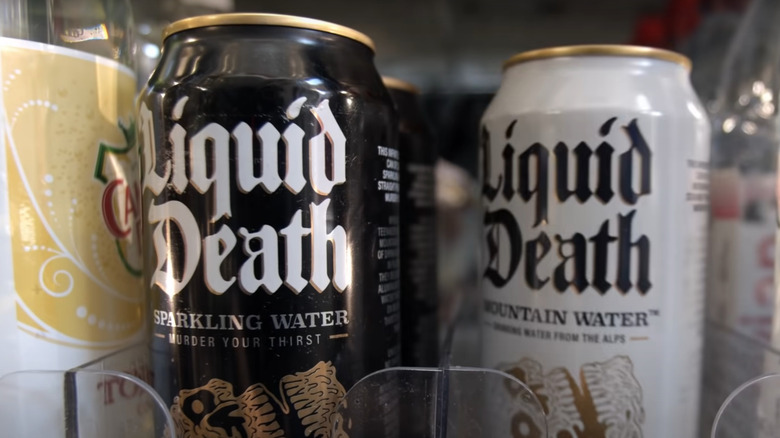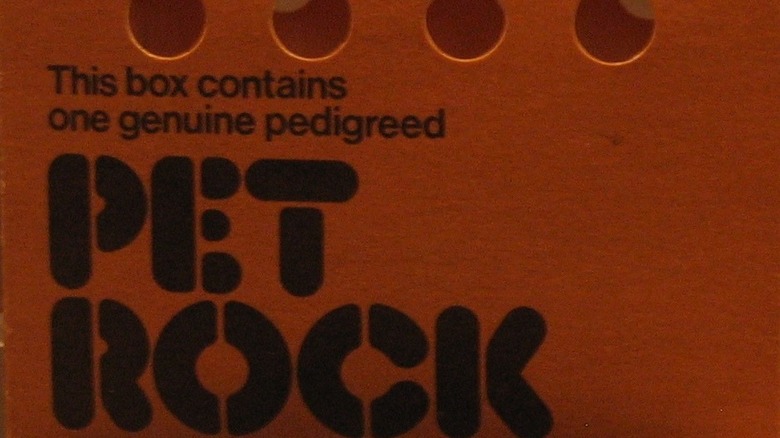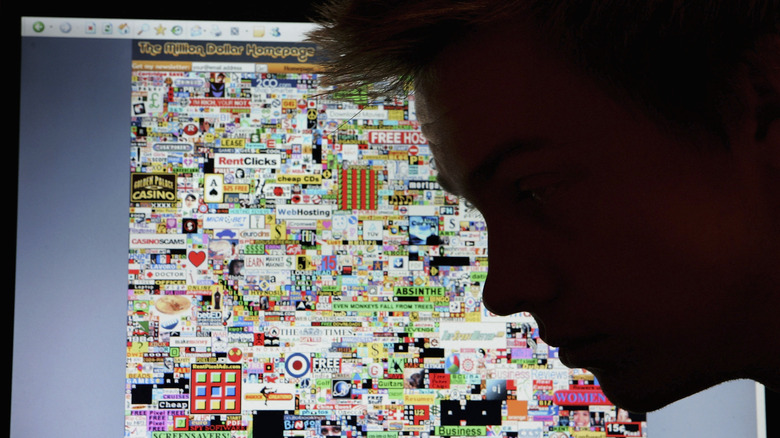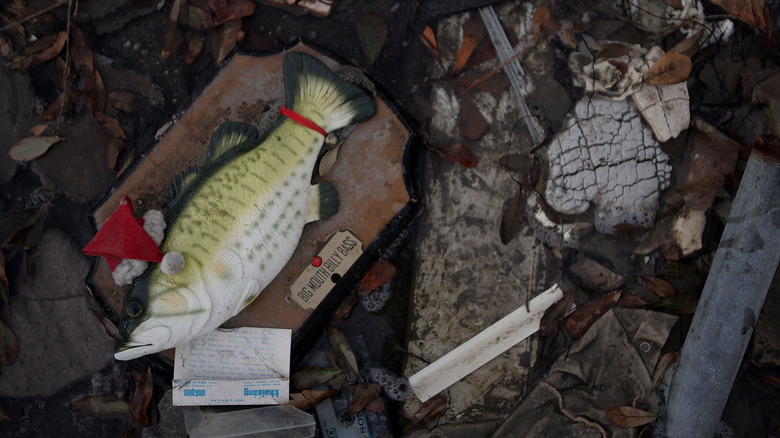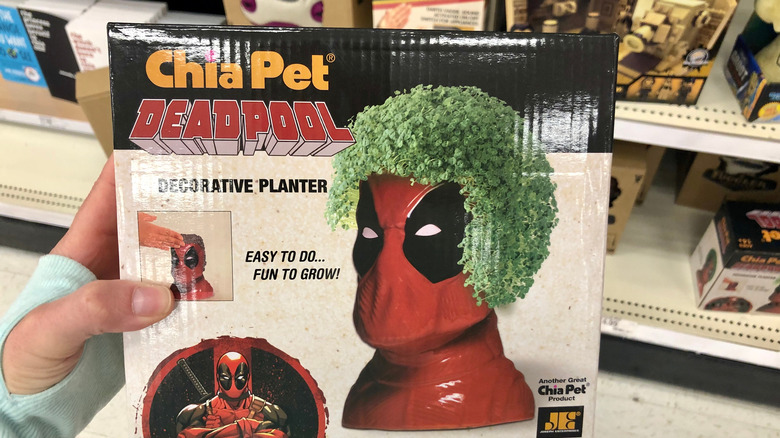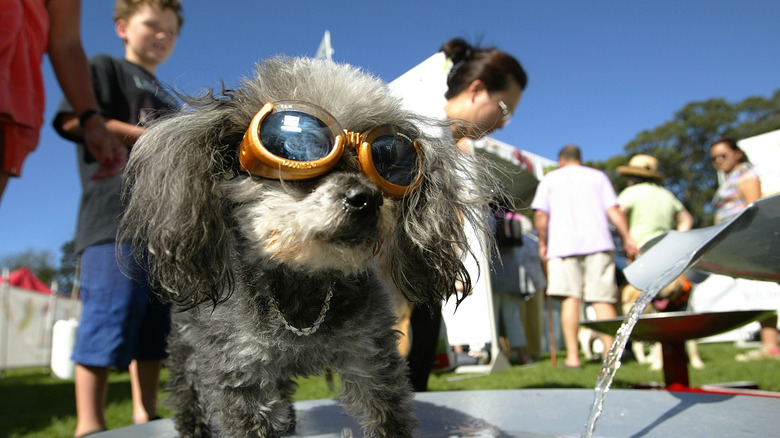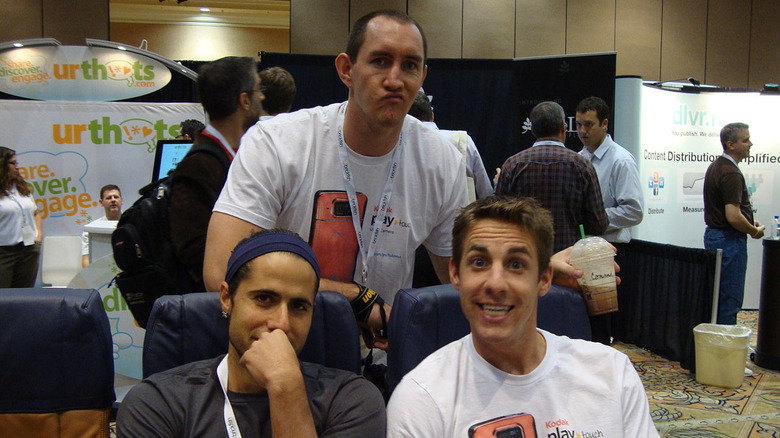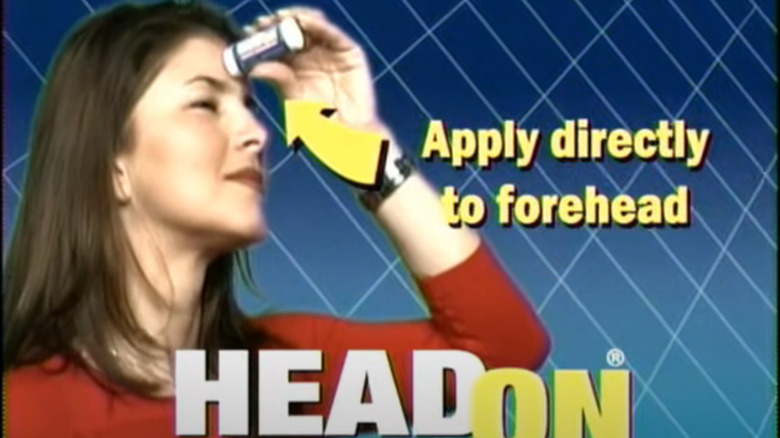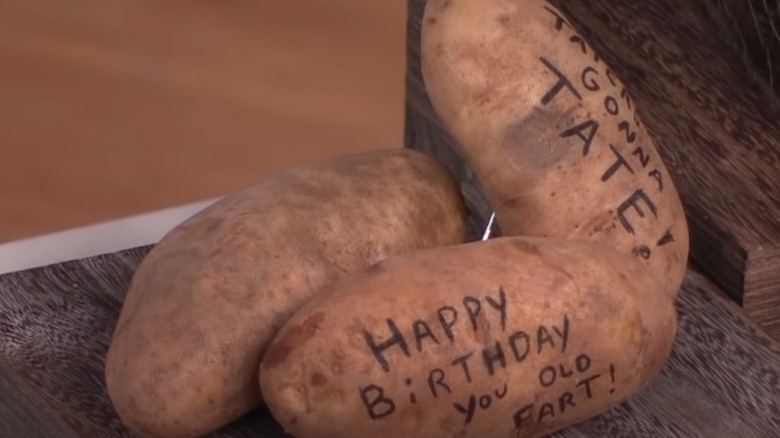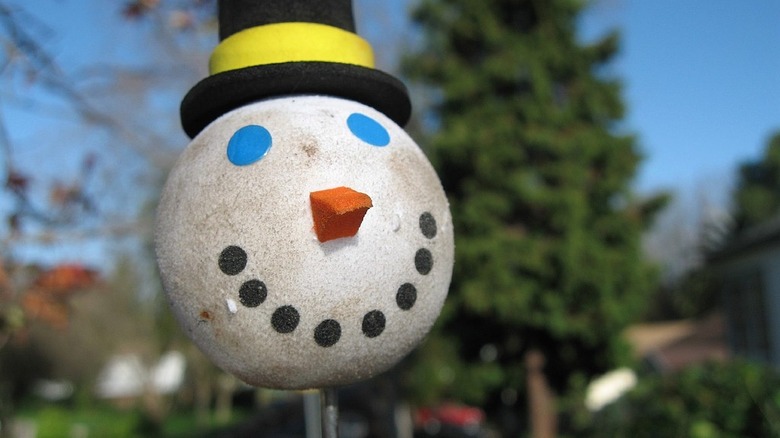Ridiculous Ideas That Made A Ton Of Money
The American Dream means different things to different people, but because this is America, after all, it usually involves becoming pretty rich. But also because this is America, most of our dreams of hitting it big don't involve winning the lottery and getting free money — most of us want to invent something, launch a business, or otherwise change the world. The getting rich part is typically secondary.
So we're a nation of hustlers, all constantly noodling on how to come up with an idea that will blow up and make a stack. Sometimes those ideas are pretty brilliant — who wouldn't want to be whoever Satoshi Nakamoto is, sitting on $30 billion in bitcoin? But sometimes the ideas that make a ton of money for someone are a little ... less brilliant than the blockchain. In fact, some of the ideas that have made people rich over the years are downright ridiculous.
But just because an idea is ridiculous doesn't mean it won't sell, and sell briskly. Sometimes the ludicrous nature of an idea is actually part of its selling point, a case where the stupidity goes so deep it wraps back around into brilliance. Or sometimes a ridiculous idea simply catches fire on a trend at the moment, and by the time everyone realizes how dumb it is, the creators have already laughed their way to the bank several times. Whatever the mechanism, here are some ridiculous ideas that made a ton of money.
Liquid Death: Literally just water
Imagine something that falls out of the sky on a regular basis and that is pumped into our homes at incredibly low cost — yes, we're talking about water. While smart folks figured out a long time ago that you can sell water at high prices if you offer some sort of perceived "value" like flavoring, purity, or convenience, Liquid Death has really carved out a place on the list of Ridiculous Ideas. Because as The Washington Post points out, it's literally just mountain water. Literally — there's no additive, no twist, no vitamins or flavoring. It's 100 percent water.
What it does have is a marketing plan and attitude. As noted by Creative Bloq, Liquid Death came up with a marketing campaign so dumb it's made them millionaires. Liquid Death is packaged in a tallboy can that looks like cheap beer or the world's worst energy drink, and its tagline in advertisements is, "murder your thirst." Targeting male-dominated subcultures like the punk music scene, the brand quickly established itself as a real, actual player in the bottled/canned water market and quickly began raising obscene amounts of investor money, according to Tech Crunch.
It's not all ridiculous, however, The New Yorker notes that by using aluminum cans instead of plastic bottles, Liquid Death is instantly the most environmentally-friendly packaged water option, and the company also donates a portion of its sales to support ocean recovery.
The Pet Rock: IT IS A ROCK
The Pet Rock is a product so dumb it's been a joke for decades. And yet, the joke is on all of us, because the dude who invented the Pet Rock, which is, it must be stressed, nothing but a rock, became a millionaire as a result of this ridiculous idea.
As reported by ABC News, Gary Dahl had the idea for the Pet Rock while with friends sitting in a bar (which ... absolutely tracks). Introduced in 1975, the rock came in a "pet carrier"-type box complete with air holes and a funny guide to caring for your rock which stressed that "playing dead" was its best trick.
Silly, yes, but the money wasn't. According to CNN, Dahl sourced his rocks for a penny each from Mexico and sold them for $3.95. He was soon selling 100,000 a day and, according to Entrepreneur, had sold 1.5 million in just a few months. His profit margin was an insane 95 cents per unit. The surest sign that Dahl got rich from this incredibly dumb idea? According to The New York Times, his original investors sued him in the late 1970s seeking a bigger share of the profits.
As noted by Groovy History, part of the Pet Rock's success was the fact that everyone was in on the joke. But it was just a crazy fad that fizzled out by the next year — by then, Dahl was already rich.
The Million Dollar Homepage: Pixels for sale
From the perspective of Web 2.0 and slick phone apps that can do everything from control the temperature of our homes to augment reality itself, the early days of the Internet seem quaint. Back then a website was typically a garish, static thing with, at best, some clunky animated GIFs to entertain and distract. But a man named Alex Tew had a brainstorm: Why not monetize a simple website?
As reported by BBC Worklife, Tew was trying to pay his way through school in 2005 when he created a web page that was simply 1,000 pixels wide by 1,000 pixels tall. Then he offered to sell those pixels (in blocks of 10x10) for exactly $1 per pixel (you could also put a hyperlink behind your pixels, making this into an advertising opportunity). That instantly gave his website a valuation of $1 million, which was ridiculous, since his pixels weren't any different than the infinite number of pixels on other websites.
And yet, Tew laughed all the way to the bank. Within four months he'd sold all of his pixels. According to the Library Innovation Lab at Harvard, because some of the later pixels were auctioned off, Tew actually earned $1,037,100 for the stunt. The page today serves as a snapshot of the Internet in 2005, but most of the links placed behind those pixels are either defunct or now redirect to other places.
Big Mouth Billy Bass: A. Singing. Fish
Chances are you've seen a Big Mouth Billy Bass in real life. The novelty product mimics a mounted fish on a plaque, like the ones displayed by proud fishermen. But motion sensors would detect whenever someone was near, and the fish would start to flop and lip-sync to a variety of songs (Al Green's "Take Me to The River" was the initial ironic choice, followed by Bobby McFerrin's "Don't Worry, Be Happy"). Hilarious!
According to Mel Magazine, inventor Joe Pellettieri began working for toy company Gemmy in 1998 and had the idea for Big Mouth Billy Bass soon afterward. It took him a year to create a prototype that worked well. According to The Hustle, the novelty toy took off in fishing stores and novelty outlets like Spencer's Gifts right away. Within a few months, big national chains like Walmart and Target had picked up Big Mouth Billy. By the holiday season, the toy had become a full-on viral phenomenon — a phenomenon that cost Gemmy $4.50 to make, and which sold for $29.95 (and often went for three times as much on eBay). In the first year alone, Big Mouth Billy Bass made $100 million.
The popularity of Big Mouth Billy Bass faded pretty quickly. The toy is still available for sale, and according to the Florida Times-Union there's even a model that will connect to your Amazon Alexa and sync its movements to the songs on your playlists.
The Chia Pet: Not much better than a pet rock
On the one hand, there's certainly nothing wrong with a terracotta figurine coated in chia seeds and filled with water, resulting in a lush green coat of "fur." For a few weeks, you'll be charmed by the sight of a turtle or a celebrity head sprouting delicate green herb-hair.
That's it, that's the whole idea. The chia herb isn't very useful, doesn't last long, and actually becomes overgrown very quickly, so even the kitsch charm of having a Chia Shrek soon looks like a weedy mess. And yet the Chia Pet has been an enormous success for decades and has made a man named Joseph Pedott pretty rich. According to the official Chia Pet website, he's sold more than 15 million of the things.
Pedott didn't invent the Chia Pet. According to Adweek, a man named Walter Houston came up with the idea in 1973. For years, he struggled to make a profit. According to Smithsonian Magazine, his business partners in Mexico overcharged him for his materials, so when Pedott came across one of his creations and offered to buy the rights, Houston was happy to do so. Pedott smoothed out the manufacturing process and came up with one of the all-time genius advertisements sporting the famous stuttered jingle, "Ch-ch-ch-chia!"
Chia Pets have moved into the modern age, with all sorts of tie-ins and even an animated series planned around the brand. So maybe it's not so ridiculous, after all.
Billy Bob Teeth: Novelty ... teeth
You might not think that a set of acrylic novelty teeth would be the key to becoming a millionaire. After all, Halloween stores and novelty shops have been selling fake teeth for decades. But back in 1994, Mel Magazine reports that a dentistry student named Rich Bailey amused himself by cooking up a set of funny fake teeth in his school's dental lab. He called them Billy Bob Teeth and wore them to a college football game, where a man named Jonah White saw him. White, who had been seeking a novelty item to sell, was mesmerized by the teeth. He sold his prized Springfield .45 handgun for $400 and started manufacturing the teeth and selling them.
They're dumb, but that's the point, and it worked. According to SUCCESS, White has sold tens of millions of the teeth. In 1997, they began manufacturing "Austin Powers" teeth, and in 2014, they signed a deal to have Miley Cyrus promote Miley-Bob teeth, according to Popcrush. Today White is a millionaire many times over. In fact, The Telegraph reports that — inspired in part by the success of the straight Austin Powers teeth — White launched a new division using his powers for good, making temporary teeth for people awaiting dental procedures. Now, a variant of the company's fake teeth is designed to cover bad teeth and improve peoples' smiles.
Doggles. Sunglasses for your poor, suffering, humiliated dog
As a species, human beings take inordinate delight in dressing up animals in human-style clothes. From funny hats on hamsters to monkeys in uniform, we love to see our furry friends dressed like us. So it's not too surprising that someone eventually came up with sunglasses for dogs.
As reported by CNBC, Roni Di Lullo got the idea when she was playing Frisbee with her dog, Midknight, back in 1997. Noting that Midknight seemed to struggle to catch the Frisbee when facing the setting sun, Di Lullo realized that she was wearing sunglasses to protect herself from the sun, so why couldn't Midknight? Di Lullo tried adapting existing human sunglasses but eventually created the initial design on a CAD program. She invested $25,000 of her own money into the business.
At first, things were small-scale. Then, in 2002, Di Rullo sent an unsolicited sample to PetSmart, and the company decided to stock Doggles in all of its stores. According to NBC News, by 2015, she sold $3 million worth of Doggles. Aside from offering dogs protection from UV rays, they also protect dogs' eyes when riding with their humans on motorcycles and have been used by some veterinarians to protect their eyes after surgery. So maybe Doggles isn't so ridiculous after all.
I Wear Your Shirt. Exactly what it says on the tin
The American Dream is to come up with an idea that will make you rich — preferably without too much effort. Back in 2009, Jason Sadler came up with one such idea, an idea so ridiculous it simply had to be wildly successful: I Wear Your Shirt.
As explained by The Los Angeles Times, the concept is simple: Everyday companies could pay Sadler to wear a branded T-shirt. Then he would take photos and videos of himself wearing the shirt and post them around the Internet. Sadler came up with a gimmicky pricing scheme to maximize his income: On January 1, 2009, it cost $1 for him to wear your shirt. Every day after that, the cost increased by $1 until December 31 cost $365. That equaled an annual income of $66,795, which isn't bad for getting dressed every day.
According to Huffpost Small Business, within two years Sadler was making six figures. And as reported by The Globe and Mail, during the five years that I Wear Your Shirt was active, he earned about $1 million from 1,600 clients. As reported by ABC News, Sadler's next project was Buy My Last Name. Sadler offered to change his name legally to the highest bidder. He did just that in 2013, becoming Jason HeadsetsDotCom.
icanhascheezeburger: it's cat memes all the way down
If you drill down into Internet history deep enough, you will eventually hit I Can has Cheezburger. One of the first meme sites to hit the web, it was, for a while, an incredibly successful platform. As noted by CNET, back in the early 2000s one of the earliest memes to worm its way around the Internet was the LOLCat phenomenon — hilarious, misspelled and frequently edgy captions attached to cute pictures of cats. In January 2007 Eric Nakagawa and Kari Unebasami came across a LOLCat depicting a fuzzy gray cat demanding to know if, "I can has cheezburger?" They thought it was so hilarious they created a site based on it where people could upload their own LOLCat memes.
So far, so dumb — we're talking about mildly entertaining cat pictures literally anyone can make, after all. But the site exploded in popularity and traffic was soon too much for Nakagawa and Unebasami to handle. Just a few months after it launched, journalist Ben Huh and a group of investors bought it for $2 million. According to TechCrunch, Huh grew the site into a network of meme-based sites with 16.5 million users, and in 2011 it raised $30 million in investment money to keep up its growth.
Today the Cheezburger Network remains active, even though it's no longer the dominating cultural phenomenon that it once was.
HeadOn: APPLY DIRECTLY TO THE FOREHEAD
Back in 2006, millions of people settled down to watch some late-night television, only to witness one of the most important events in our history: The debut of the puzzling, irritating, mesmerizing commercial for HeadOn. The commercial depicted a woman using the product as described but offered exactly zero information about what HeadOn was or what it was actually used for.
According to CBS News, this was intentional: HeadOn was originally designed as a homeopathic headache cure, but earlier advertisements claiming its efficacy ran afoul of the Better Business Bureau because HeadOn didn't work. At all. In order to escape any further problems, the makers of HeadOn simply removed all information. Because it did not work.
The mysterious ad that resulted from this decision instantly made HeadOn a viral hit. As noted by Slate, the ad's use of repetition, low production values, and mystery drove people to investigate what the product was and spread the commercial far and wide around the Internet. And that resulted in big money. According to Crain's Detroit Business, sales of HeadOn reached $6.5 million in 2006. The previous year's sales were only $1.9 million. You can still buy HeadOn today, but there's still no reason to believe it will do anything at all to relieve your headache.
Potato Parcel: So dumb it's wildly successful
According to the New York Daily News, when Alex Craig came up with the idea for a business that sent potatoes with messages on them to people, his girlfriend had zero faith in the idea — doubting he would sell even one potato and calling the idea stupid. As it turns out, she was right about the second part, but not the first. Not only did Craig earn $2,000 in two days with this ridiculous idea, but according to Quartz he sold the concept for $40,000 just five months later, and the business was soon raking in $25,000 a month.
In 2016, the company appeared on "Shark Tank." CNBC reports that entrepreneur Kevin O'Leary invested $50,000 in exchange for a 10% stake and a royalty agreement. Potato Parcel began pulling in six figures of revenue annually after that appearance. And according to the Dallas Observer, Craig, knowing that the business would be featured on "Shark Tank" after he sold it, negotiated his own $1 royalty on every potato sold after the show aired. In 2017, Sports Illustrated reports that Potato Parcel pulled off a viral marketing coup when they sent potatoes anonymously to more than 100 NBA players, generating a ton of buzz.
The business is still going strong today. They source their potatoes from local supermarkets and write on them with regular pens, which means the one thing you shouldn't do with your potato parcel is eat it.
Antenna Balls: Balls. For your antenna
If you're old enough, you might remember a time when every car had an antenna — a thin piece of metal that stood up like a flagpole in order to reel in radio signals. And if you remember that, you might remember that a lot of people liked to stick "toppers" on them — decorative, typically ball-shaped hunks of foam or plastic. According to The News Wheel, in 1962, Union 76 gas stations introduced a new sign: A rotating orange ball with "76" printed on it. To promote the new look, the company distributed thousands of antenna balls. They quickly became a fad. According to Seattlepi.com, in the 1990s the fast-food chain Jack in the Box began selling antenna balls shaped like their mascot, Jack, which proved wildly popular.
People began customizing their antenna balls themselves, and soon several successful businesses were launched, including Wally Balls and Coolballs. These businesses flourished. In 2000, Wally Balls sold more than 4 million antenna toppers, and Coolballs was earning six figures a year selling the antenna toppers (via Seattlepi.com).
While you can still buy antenna balls, most cars no longer have those old-school antennas to put them on. As noted by Jalopnik, today's car antenna is either buried in the windshield or is a small shark fin-like hump, not a flagpole-like piece of metal. But for a while, antenna balls were big, dumb business.

